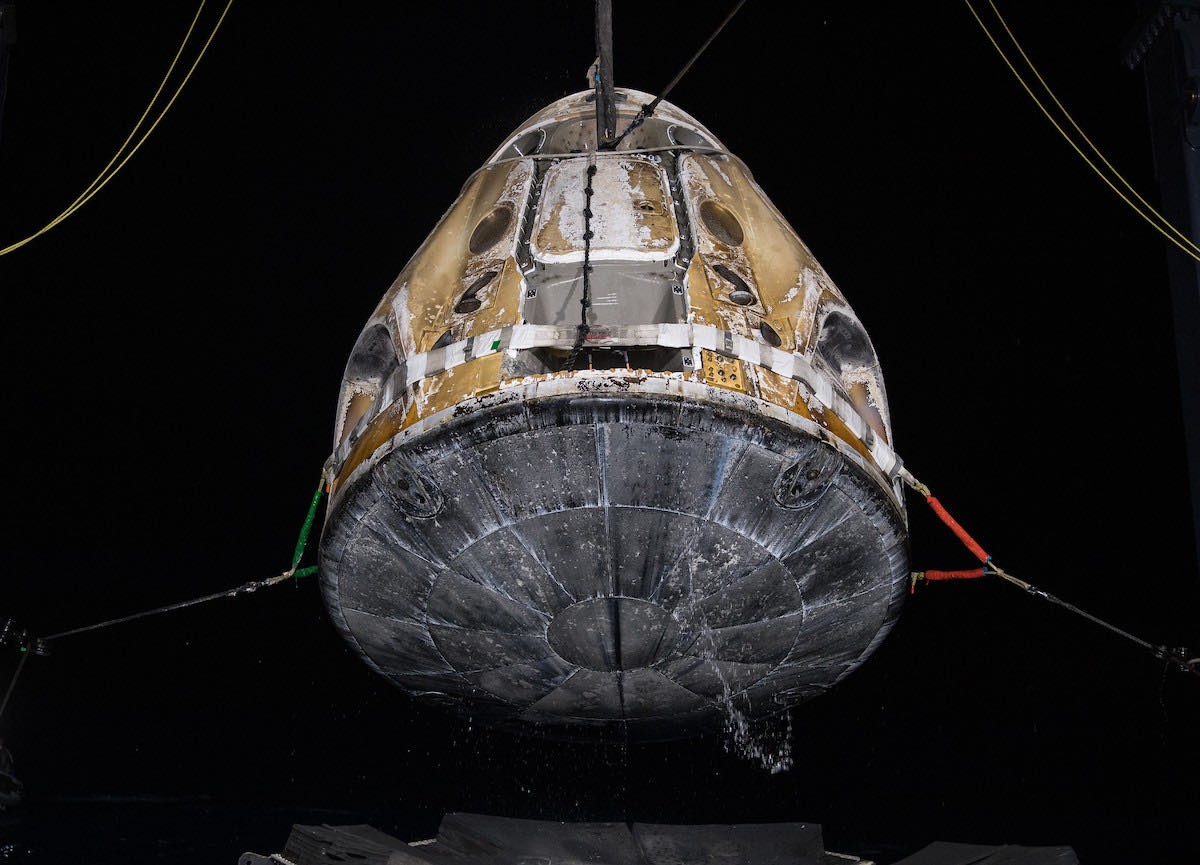Space News & Blog Articles
SpaceX swapping heat shield for next crew flight due to ‘manufacturing defect’
 SpaceX’s Dragon Endurance spacecraft after splashdown May 6, with its heat shield displayed toward the camera. Credit: NASA/Aubrey Gemignani
SpaceX’s Dragon Endurance spacecraft after splashdown May 6, with its heat shield displayed toward the camera. Credit: NASA/Aubrey Gemignani
SpaceX’s next crew mission to the International Space Station, set for launch in September, will fly with a different heat shield structure than originally planned after a composite substrate failed in acceptance testing due to a “manufacturing defect,” NASA said Tuesday.
The heat shield’s 13-foot-diameter (4-meter) composite structure — located at the bottom, blunt end of the Dragon capsule — is detachable and interchangeable between the reusable spacecraft in SpaceX’s Dragon fleet. SpaceX installs thermal protection tiles on the composite structure to protect the spacecraft from the searing heat of atmospheric re-entry at the end of each mission.
“SpaceX has a rigorous testing process to put every component and system through its paces to ensure safety and reliability,” NASA said. “In early May, a new heat shield composite structure intended for flight on Crew-5 did not pass an acceptance test. The test did its job and found a manufacturing defect. NASA and SpaceX will use another heat shield for the flight that will undergo the same rigorous testing prior to flight.”
NASA purchases crew transportation flights from SpaceX to ferry astronauts to and from the space station, and oversees SpaceX’s commercial crew and cargo contracts.
The Crew-5 mission will be SpaceX’s fifth operational crew rotation flight to the space station, and the eighth flight of a Dragon spacecraft with astronauts on-board. The four Crew-5 astronauts will replace the Crew-4 astronauts who launched to the space station April 27.
NASA said agency managers and SpaceX officials are “currently in the process of determining hardware allocation” for the Crew-5 mission. That hardware allocation includes the Dragon heat shield, NASA said.
“Crew safety remains the top priority for both NASA and SpaceX and we continue to target September 2022 for launch of Crew-5,” NASA said.
SpaceX did not respond to questions from Spaceflight Now.
The Crew-5 mission will be commanded by NASA astronaut Nicole Mann and piloted by Josh Cassada, both first-time space fliers. Veteran Japanese astronaut Koichi Wakata, on his fifth trip to space, will join them for a half-year mission on the space station.
Russian cosmonaut Anna Kikina is training to fly in the fourth seat, and would become the first Russian to launch on a Dragon spacecraft, assuming the U.S. and Russian governments can finalize an agreement for the mission some time next month. NASA wants to secure a no-funds-exchanged agreement with the Russian space agency to fly Russian cosmonauts to the station on U.S. vehicles in exchange for NASA crew seats on Russian Soyuz missions.
SpaceX has four Dragon crew capsules in its fleet. The Dragon Freedom spacecraft is currently docked at the space station, and the Dragon Endeavour and Dragon Endurance capsules returned from missions to the station April 25 and May 6.
The Dragon Resilience spacecraft, which hasn’t flown since last September, is likely to be flown again on the all-private Polaris Dawn crew mission late this year, according to Jared Isaacman, Polaris Dawn commander.
NASA said the recent returns of the Dragon Endeavour and Dragon Endurance spacecraft were normal.
The Dragon Endeavour spacecraft splashed down in the Atlantic Ocean near Florida on April 25, wrapping up a 17-day commercial crew mission to the space station with a retired NASA astronaut and four paying passengers. On May 6, SpaceX’s Dragon Endurance capsule parachuted into the Gulf of Mexico with three NASA astronauts and a European Space Agency mission specialist on the Crew-3 mission, concluding a six-month expedition on the station.
“The system performed as designed without dispute” on the Ax-1 and Crew-3 re-entries, NASA said.
An online report posted by SpaceExplored.com on Monday claimed that a leak of hypergolic propellant — used by the Dragon’s propulsion system — may have contaminated the heat shield, causing damage during the return to Earth. NASA said Tuesday that wasn’t true.
“There has not been a hypergol leak during the return of a crewed Dragon mission nor any contamination with the heat shield causing excessive wear,” NASA said. “SpaceX and NASA perform a full engineering review of the heat shield’s thermal protection system following each return, including prior to the launch of the Crew-4 mission currently at the International Space Station.”
The Crew-4 mission was the first SpaceX astronaut mission to fly with a refurbished composite heat shield structure. The tiles bonded to the substrate are new on the Crew-4 mission, NASA said.
SpaceX has reused “selected” tiles on Dragon cargo missions to the space station, according to NASA.
The next Dragon cargo flight is set for launch June 7 from NASA’s Kennedy Space Center. The SpaceX cargo freighter will launch on top of a Falcon 9 rocket.
The Dragon spacecraft used for cargo and crew missions are similar in design, but the cargo version lacks the seats, touchscreen controls, and some life support systems necessary to accommodate astronauts. The cargo variant also does not have a launch escape system to push itself away from the Falcon 9 rocket in the event of a launch failure.
SpaceX’s Dragon spacecraft is the only U.S. vehicle currently certified to carry astronauts to the space station. NASA hopes Boeing’s Starliner crew capsule, which launched last week on a long-delayed unpiloted test flight, will soon give the agency a second domestic option for astronaut missions, alongside the SpaceX Dragon and the Russian Soyuz spacecraft.
This email address is being protected from spambots. You need JavaScript enabled to view it. the author.
Follow Stephen Clark on Twitter: @StephenClark1.
When you subscribe to the SpaceZE News Feed, we will send you an e-mail when there are new updates on the site so you wouldn't miss them.

